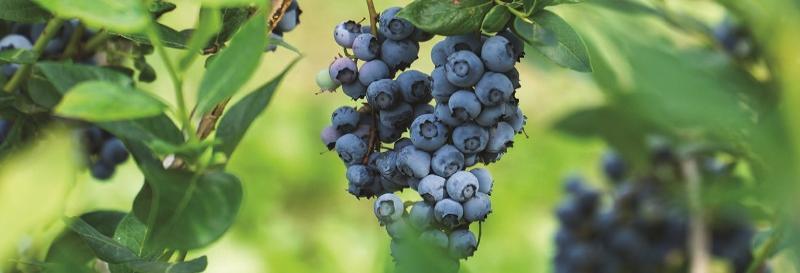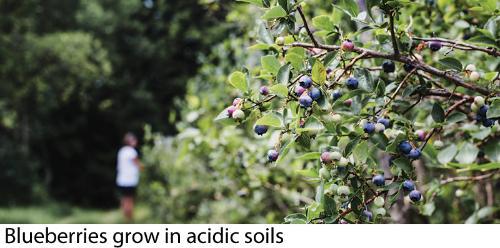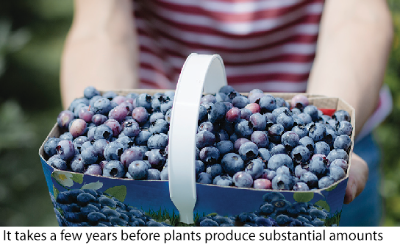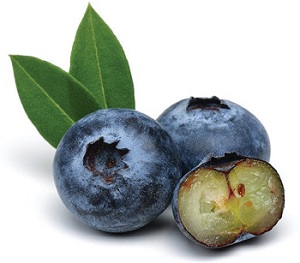Fresh Blueberry Production

Fresh Blueberry Production (PDF)
Locally grown is best

Blueberries are one of the more unusual soft fruit crops grown in Ireland. Blueberries are perennial flowering plants, which produce berries each year. They belong to the genus Vaccinium and are acid-loving plants. Both the wild (low bush) and the cultivated (high bush) are native to North America. Most of the varieties we grow today were also bred in the United States. The most popular varieties grown in Ireland are Bluecrop, Duke, Draper and Brigitta.
Traditionally in Ireland, blueberries were planted on some old cutover bogs, where the acidity was ideal for the crop. Recently, blueberries have been planted on more traditional soils. The acidity (pH) of the soil can be ameliorated and managed over time to suit the crop.
Benefits of blueberry production
- can be grown for local supply in almost any part of the country
- customers have a preference for locally grown product
- provides an excellent income – can supplement an existing job, as most of the work is seasonal
- provides local employment
- is very environmentally sustainable
Protective cropping ang growing season
Ideally, blueberries should be protected from the weather. Tunnels must also be netted to prevent attacks from birds. The blueberry season is short (approximately six to eight weeks). This can be lengthened and staggered with the use of different varieties. One of the main advantages of protective cropping is that it allows for the supply of fruit outside of the traditional short, late summer season. With protection, blueberries will be harvested from late June until early August. This all depends on the varieties chosen.
With protective cropping, fruit quality is also much higher. Protective cropping also allows the fruit to be harvested in unfavourable weather, giving pickers a much more comfortable environment to work in. The most common type of protection used is Spanish tunnels. These are multi-span tunnels, which were developed originally in Spain for the production of protected soft fruit crops.
Modern production of blueberries
 Blueberry plants will produce fruit in the first year of production, but the amount will be small. It will take three to four years for a substantial harvest. Once established in the soil and looked after correctly, the crop could last for well over 30 years. Crops grown in containers will last much less time, as the crop will get root bound over time.
Blueberry plants will produce fruit in the first year of production, but the amount will be small. It will take three to four years for a substantial harvest. Once established in the soil and looked after correctly, the crop could last for well over 30 years. Crops grown in containers will last much less time, as the crop will get root bound over time.
Most of the planting stock is imported at two years old in containers (usually 1.5L). When grown in the soil, it is recommended to plant 3,250 plants per hectare in rows, with 2.75m between the rows. If planting in containers, pots are usually a minimum of 20L in size with 11,500 pots per hectare. This container density is very high and is just one example of a planting density.
If a crop is planned for your soil, the pH must be tested beforehand. If alkaline the pH must be brought down to 4.5-5.0. This is done with the addition of peat to the soil, an annual topping up of organic matter, and through the use of ammonium-based nitrogen- phosphorus-potassium (NPK) liquid feed. The feed is delivered to the crop by drip-line irrigation, using a fertiliser-injection system. Some crops are already grown using these production methods in Ireland. These perform very well once the pH is adjusted and maintained for the crop
Markets
 Blueberries are supplied to several Irish retailers and wholesalers. Local sales in terms of local shops, farmers’ markets and roadside sales are also very important outlets. Growers wishing to enter the market need to seek out opportunities in their area, where there may be a shortage of local blueberry supplies.
Blueberries are supplied to several Irish retailers and wholesalers. Local sales in terms of local shops, farmers’ markets and roadside sales are also very important outlets. Growers wishing to enter the market need to seek out opportunities in their area, where there may be a shortage of local blueberry supplies.
Facts and Figures
There are excellent opportunities for new entrants to supply the local market. The national crop is valued at an estimated €1m, but we import at least €20m worth per annum. All blueberries grown are sold and consumed in Ireland. Protected cropping is the mainstay. The season can be extended by using different varieties and protective covering. Blueberries are seen as healthy and nutritious by the consumer. Growing methods are very advanced in terms of sustainable farming.
Grants available
Any project undertaken may be eligible for a capital grant of up to 40% (50% for those aged under 35) from the Department of Agriculture, Food and the Marine (DAFM). This scheme is competitively based and is for new capital investments in the commercial horticulture sector only.
Yields and returns
Returns from a 1ha field-grown crop – expect 1-2kg of fruit per bush two years after planting. At full crop production, expect a yield of approximately 20 tonnes per hectare at €5/kg, giving a farm gate value of approximately €35,000 per hectare. Labour costs can be reduced by using a specialised picking rig available on the market
Sustainable growing
All growers must operate under the food hygiene programme of the DAFM. Growers are also encouraged to join the Origin Green sustainability programme, run by Bord Bia. Both of these programmes carry several sustainability requirements, including a reduction in carbon and energy use on the farm and the adoption of the most environmentally friendly practices possible. Growers now operate under the principles of integrated pest management (IPM). Most insect pests are now controlled by using beneficial insects. Blueberry crops are pollinated by the buff-tailed bumblebee (Bombus terrestris ssp. audax), which is native to Ireland and Britain.
Fact sheet produced by Eamonn Kehoe, Soft Fruit Advisor.
